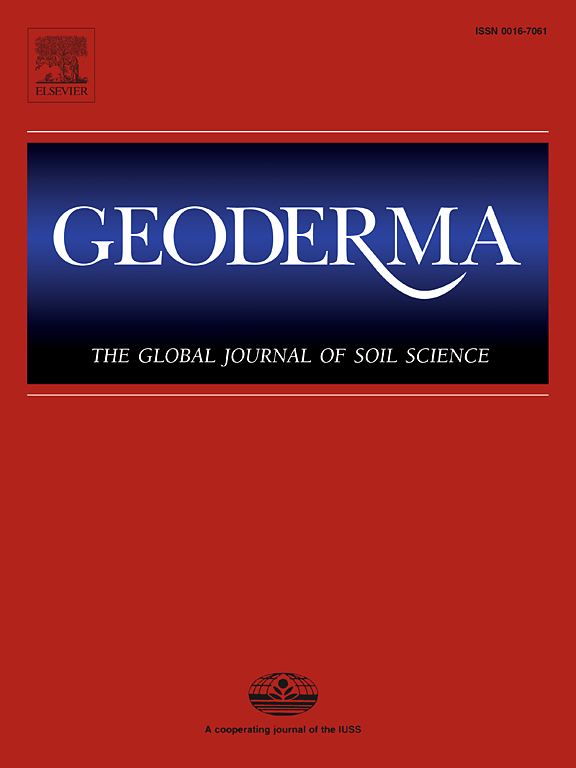Achieving the goal of the “4‰ initiative” and agricultural sustainability by co-incorporating rice straw and Chinese milk vetch for rice production in southern China
IF 5.6
1区 农林科学
Q1 SOIL SCIENCE
引用次数: 0
Abstract
The co-incorporation of rice straw (RS) and Chinese milk vetch (CMV) has been suggested as an optimized agronomic management strategy to improve soil organic carbon (SOC) storage and agricultural sustainability. This study was designed to evaluate effects of co-incorporating RS and CMV (RS-CMV) on rice grain yields, sustainable yield index (SYI), economic benefit, the sequestration and stratification of SOC, carbon fractions, and the achievement of the 4 ‰ initiative, especially under lowering 30 % N rate in southern China. Four-year field experiments were designed and implemented with four treatments: no straw incorporation as the control (CK), RS incorporation (RSI), RS-CMV, and lowering 30 % N rate based on RS-CMV (RS-CMVL). Results showed that the RS-CMV exhibited the largest annual average rice grain yields, SYI, and economic profit, higher by 6.2 ∼ 9.4 %, 6.4 ∼ 9.2 %, and 6.4 ∼ 16.8 %, respectively, than those of CK and RSI, and had no obvious discrepancy with the RS-CMVL. Throughout the 0–40 cm soil profile, the RS-CMV and RS-CMVL significanly enhanced SOC storage by 12.5 % and 12.0 % relative to the CK, by9.1 % and 8.6 % relative to the RSI, and by 10.0 % and 9.6 % relative to the pre-experimental soil (2018), respectively. The C sequestered rate per 1000 reached 25.1 ‰ year−1 and 23.9 ‰ year−1 under RS-CMV and RS-CMVL, while no difference existed between RS-CMVL and RS-CMV. As well, the RS-CMV led to the highest storages of soil labile organic carbon fractions (LOCs), especially the highly labile organic carbon, while the RS-CMVL sequestered the largest recalcitrant organic carbon throughout the entire 0–40 cm soil layer. The RS-CMV increased the stratification ratio of LOCs, while no obvious discrepancy was observed when evaluating the SR of SOC. What’s more, the cumulative carbon and nitrogen inputs are highly correlated with the storages of SOC and its LOCs, and the SYI. The co-incorporation of RS and CMV, even under lowering 30 % N rate, was mainly responsible for the improvements of rice grain yields, sustainable yield index, economic profit, SOC and its fractions’ storage, and therefore could enhance SOC sequestration and agricultural sustainability, effectively achieving the goal of the “4‰ initiative”.

实现“4‰计划”的目标和农业可持续发展,将稻草和中国豇豆用于中国南方的水稻生产
水稻秸秆与紫云英(CMV)混施是提高土壤有机碳(SOC)储量和农业可持续性的优化农艺管理策略。本研究旨在评价RS-CMV联合施用(RS-CMV)对水稻产量、可持续产量指数(SYI)、经济效益、土壤有机碳的固存和分层、碳组分以及“4‰倡议”实现情况的影响,特别是在施氮量降低30%的南方地区。设计并实施了4个4年的田间试验,分别为对照(CK)、秸秆还田(RSI)、秸秆还田(RS- cmv)和基于秸秆还田(RS- cmvl)降低30%氮肥的处理。结果表明,与对照和RSI相比,RS-CMV水稻的年平均产量、亩产量和经济效益最高,分别高出6.2 ~ 9.4%、6.4 ~ 9.2%和6.4 ~ 16.8%,与RS-CMVL无明显差异。在0 ~ 40 cm土壤剖面上,RS-CMV和RS-CMVL分别比对照提高12.5%和12.0%,比对照提高9.1%和8.6%,比试验前土壤(2018)分别提高10.0%和9.6%。RS-CMV和RS-CMVL的碳固存率分别为25.1‰/年和23.9‰/年,而RS-CMVL和RS-CMV之间没有差异。此外,RS-CMV对土壤活性有机碳(loc)的储存量最高,尤其是高活性有机碳,而RS-CMVL在整个0-40 cm土层中对顽固性有机碳的储存量最大。RS-CMV增加了loc的分层率,而评价SOC的SR无明显差异。累积碳氮输入量与土壤有机碳储量、土壤有机碳loc储量、土壤有机碳SYI高度相关。在降低30%施氮量的情况下,RS与CMV的混施对水稻籽粒产量、可持续产量指数、经济效益、有机碳及其组分储量的提高起主要作用,从而提高了有机碳的固存和农业可持续性,有效实现了“4‰计划”的目标。
本文章由计算机程序翻译,如有差异,请以英文原文为准。
求助全文
约1分钟内获得全文
求助全文
来源期刊

Geoderma
农林科学-土壤科学
CiteScore
11.80
自引率
6.60%
发文量
597
审稿时长
58 days
期刊介绍:
Geoderma - the global journal of soil science - welcomes authors, readers and soil research from all parts of the world, encourages worldwide soil studies, and embraces all aspects of soil science and its associated pedagogy. The journal particularly welcomes interdisciplinary work focusing on dynamic soil processes and functions across space and time.
 求助内容:
求助内容: 应助结果提醒方式:
应助结果提醒方式:


